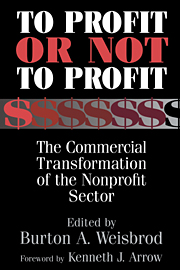Book contents
- Frontmatter
- Contents
- List of contributors
- Foreword by Kenneth J. Arrow
- Preface
- 1 The nonprofit mission and its financing: Growing links between nonprofits and the rest of the economy
- Part I Basic issues and perspective
- Part II Industry studies
- Part III Overview, conclusions, and public-policy issues
- Appendix: IRS Forms 990 and 990-T for nonprofit organizations
- References
- Index
1 - The nonprofit mission and its financing: Growing links between nonprofits and the rest of the economy
Published online by Cambridge University Press: 30 November 2009
- Frontmatter
- Contents
- List of contributors
- Foreword by Kenneth J. Arrow
- Preface
- 1 The nonprofit mission and its financing: Growing links between nonprofits and the rest of the economy
- Part I Basic issues and perspective
- Part II Industry studies
- Part III Overview, conclusions, and public-policy issues
- Appendix: IRS Forms 990 and 990-T for nonprofit organizations
- References
- Index
Summary
Introduction
Massive change is occurring in the nonprofit sector. Seemingly isolated events touching the lives of virtually everyone are, in fact, parts of a pattern that is little recognized but has enormous impact; it is a pattern of growing commercialization of nonprofit organizations:
Nonprofit hospitals are launching health clubs open to the public, with the latest exercise equipment and Olympic-size swimming pools, generating substantial profits and threatening the for-profit fitness center industry (Stone 1997).
Nonprofit museums are opening glitzy retail shops, generating revenue that is now a larger percentage of operating income than that from federal funding or admissions and memberships (Dobrzynski 1997; Mullen 1997).
Nonprofit universities are engaging in research alliances with private firms and suppressing research findings that are unfavorable to those firms' profit prospects (Altman 1997; Kolata 1997).
Nonprofits in various industries are forming for-profit subsidiaries, engaging in joint ventures with private firms, and paying executives compensation at “Fortune 500” levels (Farhi 1997; Gosselin and Zitner 1997; Abelson 1998).
Commercialism in the nonprofit sector sounds like a paradox: Nonprofits are supposed to be different from private firms, for whom commercialism is their very lifeblood. To some people, though, the uniqueness of nonprofit organizations is by no means self-evident; perhaps they are really not different from private firms, but are just as influenced by business motives and opportunities for self-aggrandizement.
Late in 1997 two apparently unrelated events brought front-page headlines.
- Type
- Chapter
- Information
- To Profit or Not to ProfitThe Commercial Transformation of the Nonprofit Sector, pp. 1 - 22Publisher: Cambridge University PressPrint publication year: 1998
- 56
- Cited by



